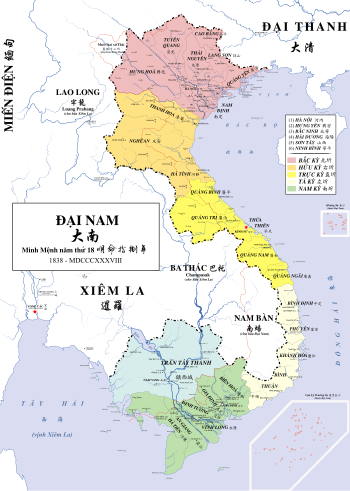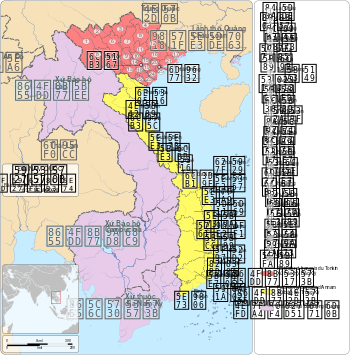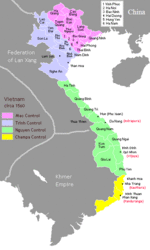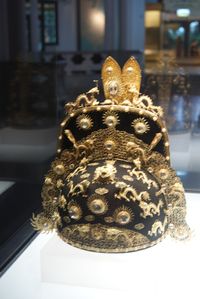أسرة وين
| ||||||||||||||||||||||||||||||||||||||||||||||||||||||||||||||||||||||||||||||||||||||||||||||||||||||||||||
أسرة وين Nguyễn Dynasty (ڤيتنامية: Nhà Nguyễn; Hán Việt: 阮朝, Nguyễn triều)، هي آخر أسرة حاكمة في فيتنام. امتد حكمها لمدة 143 عام. بدأ في عام 1802 عندما تولى الإمبراور گيا لونگ العرش بعد هزيمته لأسرة تاي سون وانتهى حكمها عام 1945 عندما تنازل باو ديا عن العرش وانتقلت السلطة غلى دولة فيتنام. أثناء حكم الإمبراطور گيا مانگ، أصبح إسم الإمبراطورية الرسمي Việt Nam (越南)، لكن منذ تولي الإمبراطور منه مانگ الحكم، أعيد تسميها باسم Đại Nam (大南، وتعني "الجنوب العظيم"). تميز حكم أسرة وين بزيادة نفوذ الاستعمار الفرنسي، وقُسمت البلاد إلى ثلاث أقسام كوچينالصين التي أصبحت مستعمرة فرنسية باسم أنام وتونكين وأصبحت محميات مستقلة بالاسم فقط.
The Nguyễn Phúc family established feudal rule over large amounts of territory as the Nguyễn lords by the 16th century before defeating the Tây Sơn dynasty and establishing their own imperial rule in the 19th century. The dynastic rule began with Gia Long ascending the throne in 1802, after ending the previous Tây Sơn dynasty. The Nguyễn dynasty was gradually absorbed by France over the course of several decades in the latter half of the 19th century, beginning with the Cochinchina Campaign in 1858 which led to the occupation of the southern area of Vietnam. A series of unequal treaties followed; the occupied territory became the French colony of Cochinchina in the 1862 Treaty of Saigon, and the 1863 Treaty of Huế gave France access to Vietnamese ports and increased control of its foreign affairs. Finally, the 1883 and 1884 Treaties of Huế divided the remaining Vietnamese territory into the protectorates of Annam and Tonkin under nominal Nguyễn Phúc rule. In 1887, Cochinchina, Annam, Tonkin, and the French Protectorate of Cambodia were grouped together to form French Indochina.
The Nguyễn dynasty remained the formal emperors of Annam and Tonkin within Indochina until World War II. Japan had occupied Indochina with French collaboration in 1940, but as the war seemed increasingly lost, overthrew the French administration in March 1945 and proclaimed independence for its constituent countries. The Empire of Vietnam under Emperor Bảo Đại was a nominally independent Japanese puppet state during the last months of the war. It ended with Bảo Đại's abdication following the surrender of Japan and August Revolution by the anti-colonial Việt Minh in the August 1945. This ended the 143-year rule of the Nguyễn dynasty.[7]
الأسماء
ڤيت نام
| Country of Vietnam | |
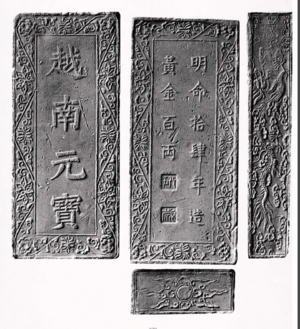 | |
| الأبجدية الڤيتنامية | Nước Việt Nam |
|---|---|
| هان-نوم | 渃越南 |
The name Việt Nam (النطق الڤيتنامي: [viə̀t naːm], chữ Hán: 越南) is a variation of Nam Việt (南越; literally "Southern Việt"), a name that can be traced back to the Triệu dynasty of the second century BC.[8] The term "Việt" (Yue) (الصينية: 越; پنين: Yuè; كانتونية يل: Yuht; ويد-جايلز: Yüeh4; الڤيتنامية: Việt) in Early Middle Chinese was first written using the logograph "戉" for an axe (a homophone), in oracle bone and bronze inscriptions of the late Shang dynasty (ح. 1200 BC), and later as "越".[9] At that time it referred to a people or chieftain to the northwest of the Shang.[10] In the early eighth century BC, a tribe on the middle Yangtze were called the Yangyue, a term later used for peoples further south.[10] Between the seventh and fourth centuries BC Yue/Việt referred to the State of Yue in the lower Yangtze basin and its people.[9][10] From the third century BC the term was used for the non-Chinese populations of south and southwest China and northern Vietnam, with particular ethnic groups called Minyue, Ouyue, Luoyue (Vietnamese: Lạc Việt), etc., collectively called the Baiyue (Bách Việt, الصينية: 百越; پنين: Bǎiyuè; كانتونية يل: Baak Yuet; الڤيتنامية: Bách Việt; literally: "Hundred Yue/Viet"; ).[9][10][11] The term Baiyue/Bách Việt first appeared in the book Lüshi Chunqiu compiled around 239 BC.[12] By the seventeenth and eighteenth centuries, educated Vietnamese called themselves and their people as người Việt and người Nam, which combined to become người Việt Nam (Vietnamese people). However, this designation was for the Vietnamese themselves and not for the whole country.[13]
The form Việt Nam (越南) is first recorded in the 16th-century oracular poem Sấm Trạng Trình. The name has also been found on 12 steles carved in the 16th and 17th centuries, including one at Bao Lam Pagoda in Hải Phòng that dates to 1558.[14] In 1802, Nguyễn Phúc Ánh (who later became Emperor Gia Long) established the Nguyễn dynasty. In the second year of his rule, he asked the Jiaqing Emperor of the Qing dynasty to confer on him the title 'King of Nam Việt / Nanyue' (南越 in Chinese character) after seizing power in Annam. The Emperor refused because the name was related to Zhao Tuo's Nanyue, which included the regions of Guangxi and Guangdong in southern China. The Qing Emperor, therefore, decided to call the area "Việt Nam" instead.[15] Between 1804 and 1813, the name Vietnam was used officially by Emperor Gia Long.[أ]
داي نام
| Empire of Đại Nam | |
| الأبجدية الڤيتنامية | Đại Nam Quốc |
|---|---|
| هان-نوم | 大南國 |
In 1839, under the rule of Emperor Minh Mạng's, official name of the empire was Đại Việt Nam (大越南, which means "Great Vietnam"), and it was shortened to Đại Nam (大南, which means "Great South").[17][18]
نام تيو
During the 1930s its government used the name Nam Triều (南朝, Southern dynasty) on its official documents.[19]
أسماء أخرى
Westerners in the past often called the kingdom as Annam[20][21] or the Annamite Empire.[22] However, in Vietnamese historiography, modern historians often refer to this period in Vietnamese history as Nguyễn Vietnam,[23] alternatively spelled as Nguyễn Vietnam, or simply Vietnam to distinguish with the pre-19th century Đại Việt kingdom.[24]
التاريخ
Background and establishment
أصل عشيرة وين
The Nguyễn family clan, originated in the Thanh Hóa Province, exerted substantial political influence and military power, in particular throughout early modern Vietnamese history. Affiliations with the ruling elite date back to the tenth century when Nguyễn Bặc was appointed the first Grand Chancellor of the short-lived Đinh dynasty under Đinh Bộ Lĩnh in 965.[25] Nguyễn Thị Anh, a queen consort of emperor Lê Thái Tông served as official regent of Đại Việt for her son emperor Lê Nhân Tông between 1442 and 1453.[26]
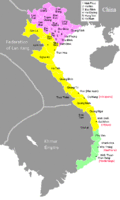
خدم أسرة لى
In 1527 Mạc Đăng Dung, after defeating and executing the Lê dynasty's vassal (Nguyễn Hoằng Dụ) in a rebellion and emerged as the intermediate victor and established the Mạc dynasty by deposing Emperor Lê Cung Hoàng of the once prosperous but rapidly declining later Lê dynasty. Nguyễn Hoằng Dụ's son Nguyễn Kim and his Trịnh clan allies remained loyal to the Lê dynasty and attempted to restore the Lê dynasty to power, thereby reigniting the rebellion.[27][28] After that, both the Trịnh and Nguyễn clan again took up arms in Thanh Hóa province and revolted against the Mạc. However the rebellion was failed and they fled to kingdom of Lan Xang where the king Photisarath allows them to establish the exiled government in Xam Neua. The Lê loyalists under Lê Ninh, a descendant of the imperial family, escaped to Muang Phuan (today Laos). During exile, Marquis of An Thanh, Nguyễn Kim summoned the people who were still loyal to the Lê emperor and formed a new army to begin a revolt against Mạc Đăng Dung. In 1540, they return to Đại Việt and begin their first military campaign against Mạc dynasty in Thanh Hóa province and capture the province in 1543.
Nguyễn's dominion in the south
Lê dynasty was restored in 1539 after the alliance recaptured Thanh Hoa Province and reinstall the Lê emperor Lê Trang Tông in throne. Nguyễn Kim, who had served as leader of the alliance during the 12 year of Lê–Mạc War (from 1533 to 1545) in the period of Northern and Southern dynasties, was assassinated in 1545 by a captured Mạc general (Dương Chấp Nhất). After that, Kim's son-in-law, Trịnh Kiểm who had killed the eldest son of Kim (Nguyễn Uông), then seize control of the alliance. The sixth son of Kim, Nguyễn Hoàng fears that his fate will be like his brother; therefore, he tried to run away from the capital to avoid the next assassination. Later, he asks his sister Nguyễn Thị Ngọc Bảo (wife of Trịnh Kiểm) to ask Kiểm to appoint him to be the governor of far-south frontier of Đại Việt, Thuận Hóa (modern Quảng Bình to Quảng Nam provinces). Trịnh Kiểm thought this was the opportunity to remove the power and influence of Nguyễn Hoàng in the capital city so he agreed with the proposal. In 1558, Lê Anh Tông, emperor of the re-established Lê dynasty appointed Nguyễn Hoàng with the lordship of the Thuận Hóa, which had been conquered during the 15th century from the Champa kingdom. This event marked the beginning of division of two powerful families in 1558, Trịnh clan rules as dictatorship in the government of Lê dynasty in the north Đại Việt (Đàng Ngoài) and Nguyễn clan rules the South Đại Việt (Đàng Trong).[29]
Nguyễn Phúc Lan chose the city of Phú Xuân in 1636 as his residence and established the dominion of the Nguyễn lord in the southern part of the country. Although the Nguyễn and Trịnh lords ruled as de facto rulers in their respective lands, they paid official tribute to the Lê emperors in a ceremonial gesture, and recognize Lê dynasty as the legitimacy of Đại Việt.
Nguyễn-Trịnh confrontation
الإمبريالية الغربية
الحرب العالمية الأولى
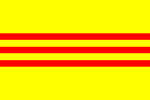
الحرب العالمية الثانية
الخلافة ورؤساء الأسرة الحاكمة
أباطرة ڤيتنام من أسرة وين
| الاسم | الاسم الأخير | الإسم الشخصي | العهد | الحقبة | الضريح الملكي | الأحداث |
|---|---|---|---|---|---|---|
| 世祖 Thế Tổ |
開天弘道立紀垂統神文聖武俊德隆功至仁大孝高皇帝 Khai Thiên Hoằng Đạo Lập Kỷ Thùy Thống Thần Văn Thánh Vũ Tuấn Đức Long Công Chí Nhân Đại Hiếu Cao Hoàng Đế |
阮福暎 Nguyễn Phúc Ánh |
1802–1820 | 嘉隆 1802–1820 گيا لونگ |
千壽陵 Thiên Thọ lăng |
وحـّد كامل البلد، مؤسس آخر أسرة حاكمة في ڤيتنام، والذي سمى البلد ڤيتنام لأول مرة |
| 聖祖 Thánh Tổ |
體天昌運至孝淳德文武明斷創述大成厚宅豐功仁皇帝 Thể Thiên Xương Vận Chí Hiếu Thuần Đức Văn Vũ Minh Đoán Sáng Thuật Đại Thành Hậu Trạch Phong Công Nhân Hoàng Đế |
阮福晈 Nguyễn Phúc Kiểu |
1820–1841 | 明命 1820–1841 Minh Mạng |
孝陵 Hiếu Lăng |
annexed the remaining of the Champa kingdom, renamed the country Đại Nam, suppress religion |
| 憲祖 Hiến Tổ |
紹天隆運至善淳孝寬明睿斷文治武功聖哲章皇帝 Thiệu Thiên Long Vận Chí Thiện Thuần Hiếu Khoan Minh Duệ Đoán Văn Trị Vũ Công Thánh Triết Chượng Chương Hoàng Đế |
阮福暶 Nguyễn Phúc Tuyền |
1841–1847 | 紹治 1841–1847 Thiệu Trị |
昌陵 Xương Lăng |
|
| 翼宗 Dực Tông |
世天亨運至誠達孝體健敦仁謙恭明略睿文英皇帝 Thể Thiên Hanh Vận Chí Thành Đạt Hiếu Thể Kiện Đôn Nhân Khiêm Cung Minh Lược Duệ Văn Anh Hoàng Đế |
阮福時 Nguyễn Phúc Thì |
1847–1883 | 嗣德 1847–1883 Tự Đức |
謙陵 Khiêm Lăng | |
| 恭宗 Cung Tông |
惠皇帝 Huệ Hoàng Đế |
— — |
1883 | 育德 1883 Dục Đức |
安陵 An Lăng | |
| — | — | 阮福昇 Nguyễn Phúc Thăng |
1883 | 協和 1883 Hiệp Hòa |
— | |
| 簡宗 Giản Tông |
紹德志孝淵睿毅皇帝 Thiệu Đức Chí Hiếu Uyên Duệ Nghị Hoàng Đế |
阮福昊 Nguyễn Phúc Hạo |
1883–1884 | 建福 1883–1884 Kiến Phúc |
陪陵 Bồi Lăng | |
| — | — | 阮福明 Nguyễn Phúc Minh |
1884–1885 | 咸宜 1884–1885 Hàm Nghi |
Thonac Cemetery, France | was dethroned after 1 year because stratagem piles the West, but continued the rebellion until was captured in 1888 and forced to exile to Africa |
| 景宗 Cảnh Tông |
弘烈統哲敏惠純皇帝 Hoằng Liệt Thống Thiết Mẫn Huệ Thuần Hoàng Đế |
阮福昪 Nguyễn Phúc Biện |
1885–1889 | 同慶 1885–1889 Đồng Khánh |
思陵 Tư Lăng |
friendly with the West |
| — | — | 阮福昭 Nguyễn Phúc Chiêu |
1889–1907 | 成泰 1889–1907 Thành Thái |
安陵 An Lăng | |
| — | — | 阮福晃 Nguyễn Phúc Hoảng |
1907–1916 | 維新 1907–1916 Duy Tân |
安陵 An Lăng | |
| 弘宗 Hoằng Tông |
嗣代嘉運聖明神智仁孝誠敬貽謨承烈宣皇帝 Tự Đại Gia Vận Thánh Minh Thần Trí Nhân Hiếu Thành Kính Di Mô Thừa Liệt Tuyên Hoàng Đế |
阮福昶 Nguyễn Phúc Tuấn |
1916–1925 | 啟定 1916–1925 Khải Định |
應陵 Ứng Lăng | |
| — | — | 阮福晪 Nguyễn Phúc Thiển² |
1926–1945 | 保大 1926–1945 Bảo Đại |
Cimetière de Passy, France | restored Vietnamese sovereignty, created the Empire of Vietnam, abdicated and transferred power to the Viet Minh, Vietnamese monarchy came to an end |
النسب
| 1 Gia Long 1802–1819 |
|||||||||||||
| 2 Minh Mạng 1820–1840 |
|||||||||||||
| 3 Thiệu Trị 1841–1847 |
|||||||||||||
| 4 Tự Đức 1847–1883 |
Thoại Thái Vương | Kiên Thái Vương | 6 Hiệp Hoà 1883 | ||||||||||
| 5 Dục Đức 1883 |
9 Đồng Khánh 1885–1889 |
8 Hàm Nghi 1884–1885 |
7 Kiến Phúc 1883–1884 | ||||||||||
| 10 Thành Thái 1889–1907 |
12 خاي دينه Khải Định 1916–1925 |
||||||||||||
| 11 Duy Tân 1907–1916 |
13 Bảo Đại 1926–1945 |
||||||||||||
ملاحظة:
- السنوات في الجدول هي سنوات حياتهم في الحكم
- أنظر أيضا: شجرة عائلة لوردات وين
انظر أيضا
- الهند الصينية الفرنسية
- قائمة الأسر الڤيتنامية
- ڤيتنام أثناء الحرب العالمية الأولى
- وين تروونگ تو - عمل بإسم الامبراطور تو دوك
وصلات خارجية
- ^ Kang, David C. (2012). East Asia Before the West: Five Centuries of Trade and Tribute. Columbia University Press. pp. 101–102.
In 1802 the Nguyen dynasty was recognized with an imperial pardon and tributary status. [...] there was no doubt in anyone's mind that China was the superior and the tributary state the inferior. The Vietnamese kings clearly realized that they had to acknowledge China's suzerainty and become tributaries [...]
- ^ Eastman, Lloyd E. (1967). Throne and Mandarins: China's Search for a Policy during the Sino-French Controversy. Harvard University Press. pp. 34–40, 201.
- ^ Eastman, Lloyd E. (1967). Throne and Mandarins: China's Search for a Policy during the Sino-French Controversy. Harvard University Press. pp. 123–124.
- ^ Brocheux, Pierre; Hémery, Daniel (2011). Indochina: An Ambiguous Colonization, 1858–1954. University of California Press. pp. 78–81.
- ^ خطأ استشهاد: وسم
<ref>غير صحيح؛ لا نص تم توفيره للمراجع المسماةLebra - ^ خطأ استشهاد: وسم
<ref>غير صحيح؛ لا نص تم توفيره للمراجع المسماةLi-Reid - ^ Lockhart, Bruce (2001). "Re-assessing the Nguyễn Dynasty". Crossroads: An Interdisciplinary Journal of Southeast Asian Studies. 15 (1): 9–53. JSTOR 40860771.
- ^ أ ب Woods 2002, p. 38.
- ^ أ ب ت Norman & Mei 1976.
- ^ أ ب ت ث Meacham 1996.
- ^ Yue Hashimoto 1972, p. 1.
- ^ Knoblock & Riegel 2001, p. 510.
- ^ Lieberman (2003), p. 405.
- ^ Phan 1985, p. 510.
- ^ Ooi 2004, p. 932.
- ^ Shaofei & Guoqing 2016.
- ^ "韩周敬:越南阮朝嘉、明时期国号问题析论". 越南历史研究. Retrieved 31 August 2018.
- ^ Toda (1882), p. 46.
- ^ Nguyễn Thu Hoài (21 January 2019). "Người lao động Việt Nam được nghỉ ngày 1.5 từ bao giờ?" (in الفيتنامية). Trung tâm Lưu trữ quốc gia I (National Archives Nr. 1, Hanoi) - Cục Văn thư và Lưu trữ nhà nước (State Records And Archives Management Department Of Việt Nam). Retrieved 2 February 2022.
- ^ Verlag (1827), p. 298.
- ^ Toda (1882), p. 41.
- ^ Hiley (1848), p. 350.
- ^ Lieberman (2003), p. 187.
- ^ Holcombe (2017), pp. 10, 11.
- ^ "Ai là tể tướng đầu tiên trong lịch sử Việt Nam? (Who is the first prime minister in Vietnamese history?)". Vietnam Union of Science and Technology Associations. 5 February 2014. Retrieved 5 February 2019.
- ^ "The development of Le government in fifteenth century Vietnam". Retrieved 2 February 2019.
- ^ Bui Ngoc Son. "Confucian Constitutionalism in Imperial Vietnam" (PDF). National Taiwan University. Retrieved 2 February 2019.[dead link]
- ^ K. W. Taylor (9 May 2013). A History of the Vietnamese. Cambridge University Press. pp. 232–. ISBN 978-0-521-87586-8.
- ^ "A GLIMPSE OF VIETNAM'S HISTORY". geocities. Archived from the original on 21 October 2009. Retrieved 2 February 2019.
خطأ استشهاد: وسوم <ref> موجودة لمجموعة اسمها "lower-alpha"، ولكن لم يتم العثور على وسم <references group="lower-alpha"/>
- Short description is different from Wikidata
- Articles with hatnote templates targeting a nonexistent page
- Missing redirects
- Articles containing ڤيتنامية-language text
- Pages using gadget WikiMiniAtlas
- Pages using infobox country or infobox former country with the flag caption or type parameters
- Pages using infobox country or infobox former country with the symbol caption or type parameters
- Pages using Lang-xx templates
- Articles containing صينية-language text
- دول وأراضي تأسست في 1802
- أسرة وين
- انحلالات 1945
- قوائم موظفين عموميين حسب البلد
- ممالك سابقة في آسيا
- حركة الاستقلال الفيتنامية
- دول سابقة في تاريخ فيتنام
- Harv and Sfn no-target errors
- CS1 الفيتنامية-language sources (vi)
- Articles with dead external links from April 2020
- مقالات ينقصها مصادر موثوقة
- مقالات ينقصها مصادر موثوقة from March 2021



